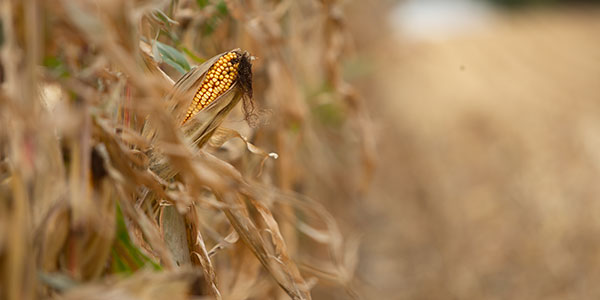AGRONOMICSUPPORT
YOU CAN TAKETO THE FIELD
Preventing Late Season Stalk Rot
Stalk integrity, late season intactness, disease susceptibility, and fungicide response are just a few of the management decisions when deciding on next year’s corn hybrids. This year brought on several new challenges that we were able to learn and grow from. Like any other year, growers are faced with different challenges, and forced to adapt.
This year several parts of the Midwest and the northern region of the corn belt were faced with mild to severe drought conditions. Corn plants were stressed early and were showing signs of nutrient deficiencies. Some small timely rains pushed the crops along, but there was not enough to keep the plants healthy enough to avoid cannibalization. Late season rains also paved the way to stalk rots. Getting closer to harvest, many areas discovered the stalk integrity was going to be a problem. Early harvest was evident, and when the corn was ready growers were advised to go get it as early as possible. Unfortunately, many areas experienced, and still are experiencing downed corn, and bushels are being left in the field.
“Stalk rot diseases tend to be more common in higher yielding hybrids that produce large, heavy ears. During time of stress, the large ears may cannibalize carbohydrates from the stalk and weaken it.” (Jackson-Ziems, Rees, & Harveson, 2014) There are several different types of stalk rot pathogens, and most of them are common in most fields in the corn belt. Certain environmental situations influence and worsen the severity of stalk rot.
Fusarium, and Gibberella are two common rots that are worsened by drought conditions early in the growing season, and wet, warm conditions late in the season. Several different pathogens can be, and are infecting the plants throughout the corn belt, so sometimes determining the right type of rot can be difficult. There are several university articles explaining the different types of stalk rots, and how to determine which one you are experiencing. The link shared below is a good reference.
Fungicides can also be a very effective way to help minimize the effects of stalk rots. Simply keeping the plant healthier and alive can help the plant stand longer, while minimizing the effects of stalk rot. Some corn hybrids have better responses to fungicides than others, so talking with your LG Seeds Dealer is critical to determine which hybrids you should be planting.
Corn hybrid selection is very critical in any aspect of crop protection. Hybrid selection is especially critical when deciding your plan for the coming year. Some fields may be corn on corn, some may be no till, others might have a known issue. It is crucial to speak early with your LG Seeds Dealer to help decide which hybrids have the best disease resistance, best stalk quality, higher response to fungicide, and the best yielding product. Visit with your LG Seeds representative and let them help you minimize your risk for lost bushels for next year.
References
Jackson-Ziems, T., Rees, J., & Harveson, R. (2014). Common Stalk Rot Diseases of Corn. Retrieved from University of Nebraska Lincoln Extension: https://extensionpublications.unl.edu/assets/pdf/ec1898.pdf






Sales Agronomist